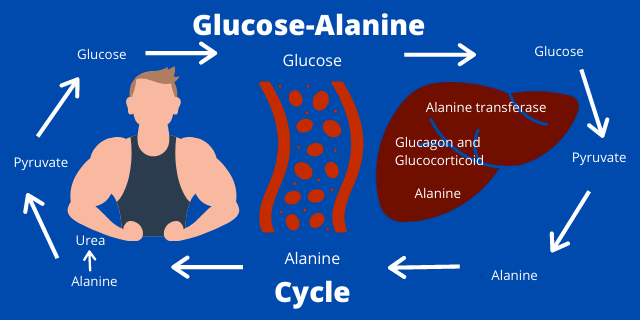People with type-2 diabetes (diabetes mellitus) are at higher risk of muscle loss and frailty. Doctors have known this for a while but the reason had not been clearly determined. Now scientists have learned that the liver function of people with type-2 diabetes may be disrupted.
A recent study published in Nature Metabolism describes this glitch in metabolic processes.[1]
Alanine is a crucial amino acid used to create proteins in the body. It is called a non essential amino acid because our bodies, specifically our skeletal muscles, produce it.
Alanine is not only a component of proteins but it is also a last resort energy source. The glucose-alanine shuttle is one of the inter-tissue processes used to produce energy during starvation conditions. The cycle begins with detection of low levels of glucose in the blood stream. Alanine from the muscles is transferred to the liver via the blood stream. In the liver, with the help of alanine transaminase (an enzyme), it is transformed to pyruvate. It is then converted into glucose and released into the bloodstream.
The recent study found that people with diabetes type-2 have chronically elevated glucocorticoid and glucagon in their livers. These elevated hormones increase the production of alanine aminotransferases. High levels of alanine aminotransferases puts the glucose-alanine shuttle in overdrive — more and more alanine is removed from the muscles. With the loss of this amino acid, skeletal muscles mass declines, as does strength. Additionally, this cycle’s stuck-status increases the amount of glucose in the blood stream.
Importantly, this study identifies the defect in metabolism that is causing people with type-2 diabetes to lose muscle mass. It also provides a solution. By targeting the liver and “silencing'” the alanine aminotrasferase enzymes, the research team was able to slow the over-production of glucose and reverse muscle atrophy. This exciting pathway to treatment could mean a reduction in disability and major improvement in the quality of life of many people with type-2 diabetes.
Reference:
[1]Okun, J.G., Rusu, P.M., Chan, A.Y. et al. Liver alanine catabolism promotes skeletal muscle atrophy and hyperglycaemia in type 2 diabetes. Nat Metab 3, 394–409 (2021). https://doi.org/10.1038/s42255-021-00369-9







How do you silence the alanine aminotrasferase enzymes in the liver?
Does this mean there is hope for those of us who are suffering muscle mass loss as a result of type 2 and, if so, how long will it take before medication to rectify the excess production of alanine aminotranferase becomes available?